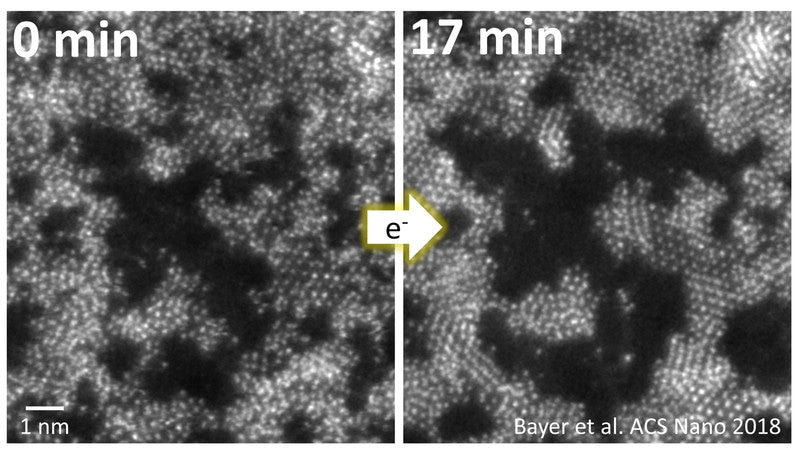Aug 30 2018
“Two-dimensional materials” are among the thinnest structures on earth. These crystals contain just one or a few layers of atoms. They frequently display rare properties, promising a number of new applications in energy technology and opto-electronics. One of these materials is 2D-molybdenum sulfide, which is an atomically thin layer of molybdenum and sulfur atoms.
 At first, the atoms are randomly distributed, after being manipulated with the electron beam, they form crystal structures (right). (Image credit: TU Wien)
At first, the atoms are randomly distributed, after being manipulated with the electron beam, they form crystal structures (right). (Image credit: TU Wien)
The production of such ultra-thin crystals is not easy. The crystallization process relies on a number of different factors. In the past, different methods have produced quite varied results, but the reasons for this could not be exactly explained. Thanks to a new technique formulated by research teams at TU Wien, the University of Vienna and Joanneum Research in Styria, for the first time ever, it is currently possible to see the crystallization process directly using the electron microscope. The technique has currently been presented in the scientific journal ‘ACS nano’.
From Gas to Crystal
Molybdenum sulphide can be used in transparent and flexible solar cells or for sustainably generating hydrogen for energy storage. In order to do this, however, high-quality crystals must be grown under controlled conditions.
Bernhard C. Bayer, Lead Author & Institute of Materials Chemistry at TU Wien
Typically this is done by beginning with atoms in gaseous form and then condensing them on a surface in a haphazard and unstructured way. In a second step, the atoms are arranged in standard crystal form—by heating, for instance. “The diverse chemical reactions during the crystallization process are, however, still unclear, which makes it very difficult to develop better production methods for 2D materials of this kind”, Bayer states.
Due to a new technique, however, it should currently be possible to accurately investigate the details of the crystallization process. “This means it is no longer necessary to experiment through trial and error, but thanks to a deeper understanding of the processes, we can say for certain how to obtain the desired product”, Bayer adds.
Graphene as a Substrate
First, sulfur and molybdenum are put randomly on a membrane made of graphene. Graphene is perhaps the best known of the 2D materials—a crystal with a thickness of just one atom layer comprising carbon atoms arranged in a honeycomb lattice. The haphazardly arranged molybdenum and sulfur atoms are then manipulated in the electron microscope using a fine electron beam. The same electron beam can be used concurrently to image the process and to start the crystallization process.
That way it has currently become feasible for the first time to straightaway observe how the atoms travel and rearrange during the growth of the material with a thickness of just two atomic layers. “In doing so, we can see that the most thermodynamically stable configuration doesn't necessarily always have to be the final state”, Bayer says. Different crystal arrangements contest with one another, alter into each other, and replace one another. “Therefore, it is now clear why earlier investigations had such varying results. We are dealing with a complex, dynamic process.” The latest findings will help to adapt the structure of the 2D materials more closely to application necessities in the future by interfering with the rearrangement processes in a targeted manner.
The study described has been financed by the FFG, FWF, and the European Commission.